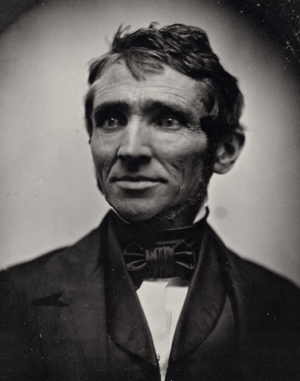Charles Goodyear facts for kids
Quick facts for kids
Charles Goodyear
|
|
|---|---|

Goodyear photographed by Southworth and Hawes
|
|
| Born | December 29, 1800 |
| Died | July 1, 1860 (aged 59) New York City, US
|
| Occupation | Engineer |
| Spouse(s) | Clarissa Beecher (m. August 1824) |
| Children |
|
| Parent(s) |
|
| Engineering career | |
| Projects | vulcanize rubber discovered in 1839, process perfected and patented in 1844. |
| Signature | |
Charles Goodyear (December 29, 1800 – July 1, 1860) was an American inventor who figured out how to make rubber stronger and more useful. His invention, called vulcanized rubber, is used in many things we use every day, like tires, shoes, and even some clothes.
Contents
Early life
Charles Goodyear was born on December 29, 1800, in New Haven, Connecticut, the son of Amasa Goodyear, and the oldest of six children. His father was a descendant of Stephen Goodyear, successor to Governor Eaton as the head of the company London Merchants, who founded the colony of New Haven in 1638.
Around 1817, when he was about 17 years old, Charles moved to Philadelphia to learn about the hardware business. He worked industriously until he was twenty-five years old, and then, returning to Connecticut, entered into a partnership in his father's business in Naugatuck, CT where they manufactured not only ivory and metal buttons, but also a variety of agricultural supplements. He had siblings Nelson Goodyear, Henry Goodyear, Robert Goodyear, Harriet Goodyear Tomlinson, Amasa Goodyear, Jr.
Rubber problem
In the early 1800s, people were very excited about rubber. It came from the sap of rubber trees in places like Brazil. This sap could be turned into a material that was soft and could be shaped. People made all sorts of things from it, like shoes and raincoats.
But there was a big problem with this natural rubber. It wasn't very strong. In hot weather, it would get sticky and melt. In cold weather, it would get hard and crack. That made it hard to use for many things. Imagine your shoes melting on a hot day!
Big idea
Charles Goodyear became very interested in rubber and wanted to find a way to make it better. He wanted to make it so it wouldn't melt or crack, no matter the weather. He thought if he could do that, rubber could be used for so many more things.
So, he started experimenting. He tried mixing rubber with different things, like powders and acids. He worked on this for years, but it was very hard. He didn't have a lot of money, and sometimes his family didn't have enough to eat. He even had to go to jail because he owed people money.
Discovery of vulcanization
One day in 1839, something amazing happened. Goodyear was working with rubber and sulfur (a yellow chemical). He accidentally dropped some of the mixture on a hot stove. Instead of melting, the rubber turned into a strong, springy material.
Goodyear realized that the heat and sulfur had changed the rubber. He called this process "vulcanization," after Vulcan, the Roman god of fire. This was a big breakthrough!
How vulcanization works
Vulcanization is like cooking the rubber with sulfur. When you heat rubber and sulfur together, the sulfur atoms make links between the long chains of molecules in the rubber. This makes the rubber stronger, more elastic (stretchy), and able to handle hot and cold temperatures without melting or cracking.
Patents and recognition
Charles Goodyear got a patent for his vulcanization process in 1844. A patent is like a special permission slip from the government that says only you can make or sell your invention. This was important because it meant other people couldn't just copy his idea.
Goodyear showed off his vulcanized rubber at exhibitions, which are like big science fairs. People were very impressed with his invention. Vulcanized rubber could be used to make all sorts of things, like shoes, waterproof clothes, and even tires for carriages.
Challenges and hardships
Even though Goodyear had a great invention, he still had a lot of problems. Other people tried to steal his idea, and he had to spend a lot of time and money fighting them in court. He won some of these cases, but it was still tough.
Goodyear also had trouble making money from his invention. He was always trying new things and experimenting, and he didn't always have the best business sense.
Legacy and impact
Charles Goodyear died on July 1, 1860, in New York City. Even though he didn't become rich, his invention changed the world. Vulcanized rubber made it possible to create many of the things we use every day.
One of the most important uses of vulcanized rubber is in tires. Without it, we wouldn't have cars, trucks, or buses! Vulcanized rubber is also used in hoses, belts, and many other things that make our lives easier.
Death and legacy
Goodyear died on July 1, 1860, while traveling to see his dying daughter. After arriving in New York, he was informed that she had already died. He collapsed and was taken to the Fifth Avenue Hotel in New York City, where he died at the age of 59.
Marriage
On August 3, 1824, he married Clarissa Beecher, whom he met at his Congregational Church. Two years later the family moved to Philadelphia.
Interesting facts about Charles Goodyear
- In 1898, almost four decades after his death, The Goodyear Tire & Rubber Company was founded and named after Goodyear by Frank Seiberling.
- The Government of France made Goodyear a Chevalier de la Légion d'honneur in 1855.
- In Woburn, Massachusetts, there is an elementary school named after him.
- The Goodyear welt, a technique in shoemaking, was named after and in honor of its inventor, Charles' son; Charles Goodyear Jr.
- The ACS Rubber Division awards a medal named in Goodyear's honor, the Charles Goodyear Medal. The medal honors principal inventors, innovators, and developers whose contributions resulted in a significant change to the nature of the rubber industry.
See also
 In Spanish: Charles Goodyear para niños
In Spanish: Charles Goodyear para niños
- Leverett Candee, first person to manufacture rubber footwear under the Goodyear vulcanization process.
- William Henry Goodyear, his son
- Goodyear Tire and Rubber Company
- Vulcanization



